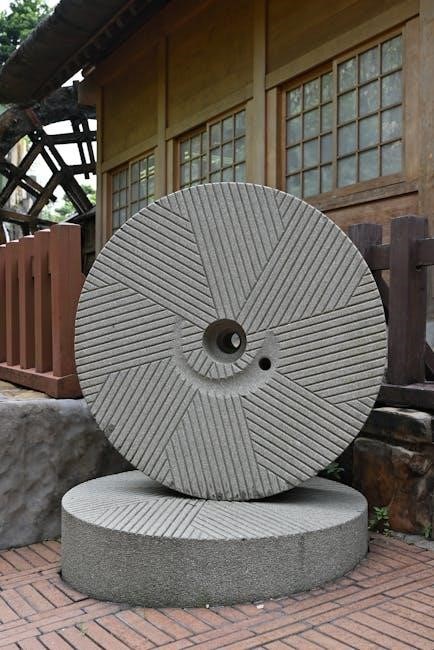Manual mills are essential tools for machining, offering precise material removal, slot creation, and drilling․ Available as knee, bed, vertical, or horizontal mills, they are versatile and cost-effective, ideal for prototyping, education, and small-scale production, with brands like Durston Tool and Kent USA leading the market․
What Are Manual Mills?
Manual mills are machining tools controlled by operators, using multi-point cutting tools to remove metal from workpieces․ Classified as vertical or horizontal based on spindle orientation, they are designed for precision and versatility․ These machines enable tasks like slot creation, drilling, and tapping, making them essential for prototyping, tool room work, and small-scale production, combining durability with ease of operation for various machining needs․
Historical Background of Manual Mills
Manual mills have a rich history, emerging as essential tools in machining during the mid-20th century․ Originally designed for precise material removal, they became foundational for training machinists, offering hands-on experience with metalworking․ Brands like Durston Tool, established in 1961, and Kent USA, have pioneered their development, ensuring durability and versatility․ These mills laid the groundwork for modern CNC machines, remaining vital in workshops and educational settings for their tactile learning benefits and reliable performance․

Types of Manual Mills
Manual mills include knee mills, bed mills, and vertical/horizontal mills, each designed for specific machining tasks, ensuring versatility and precision in various applications․
Knee Mills
Knee mills are versatile and affordable, ideal for prototype work, tool rooms, and R&D․ They feature a movable knee for precise control and adaptability, making them suitable for various machining tasks․ Brands like Kent USA offer high-quality knee mills that combine durability with ease of operation, ensuring efficient performance in both professional and educational settings․
Bed Mills
Bed mills are designed for heavy-duty machining and precision engineering․ They feature a robust bed and fixed spindle, ensuring stability during complex operations․ Suitable for large-scale production, bed mills are favored in industrial settings for their durability and accuracy․ With high-quality materials and innovative technology, they are a reliable choice for demanding machining tasks․
Vertical and Horizontal Mills
Vertical and horizontal mills differ in spindle orientation, with vertical mills suited for face milling and drilling, while horizontal mills excel in heavy-duty machining and complex cuts․ Both types ensure precision and durability, making them versatile for various applications; They are popular in industrial and educational settings, offering reliable performance for diverse machining needs․
Advantages of Manual Mills
Manual mills offer cost-effectiveness, ease of operation, and precision, making them ideal for prototyping, tool room work, and small-scale production․ Leading brands like Durston Tool and Kent USA provide reliable performance․
Cost-Effectiveness
Manual mills are a cost-effective option for machining needs․ With affordable pricing from brands like Kent USA, they offer excellent value for prototyping, tool room, and small-scale production․ Their durability and versatility reduce long-term expenses, making them a practical investment for workshops and educational settings․ This affordability ensures they remain a popular choice for various machining applications․
Ease of Operation
Manual mills are known for their user-friendly design, making them accessible to operators of all skill levels; Their hands-on nature allows for precise control, enabling machinists to feel material changes directly․ This tactile approach simplifies learning and operation, especially for new machinists․ With clear setup and intuitive features, manual mills are ideal for prototyping, tool room work, and small-scale production, ensuring efficient and straightforward machining processes․
Precision and Control
Manual mills excel in delivering high precision through their robust mechanical designs, such as gear-drive systems, ensuring accurate cuts and consistent results․ Operators can achieve precise control over material removal, enabling intricate shapes and finishes․ The tactile feedback allows for fine adjustments, making manual mills ideal for demanding tasks requiring exacting tolerances and superior craftsmanship in various machining applications․
Choosing the Right Manual Mill
Selecting the right manual mill involves considering space, budget, spindle orientation, and intended use․ Evaluate features like table size, power, and brand reputation to ensure it meets your needs․
Key Features to Consider
When selecting a manual mill, focus on table size, spindle orientation, power, and durability․ Look for high-quality materials, precise gear-drive systems, and ease of operation․ Consider brands like Durston Tool for global leadership and Kent USA for affordability․ Check for features like double inspection processes and innovative technology to ensure accuracy and longevity․ Brand reputation and customer support are also crucial for long-term satisfaction․
Top Brands in the Market
Durston Tool leads as the global leader in manual rolling mills since 1961, renowned for quality and innovation․ Kent USA offers affordable and versatile knee mills, ideal for prototyping and R&D․ Smithy provides durable gear-drive machines with excellent customer support․ Wells Index and Lagun are also notable for their robust designs and reliability, catering to both professionals and educational institutions with precision and durability․
Budget and Investment
Investing in a manual mill requires balancing cost and quality, with options ranging from $30,000 to $50,000 for new models․ Affordable brands like Kent USA offer value for small shops, while premium brands like Durston Tool and Smithy provide long-term durability․ Allocating budget wisely ensures optimal performance and return on investment for prototyping, education, and production needs, aligning with specific operational requirements and goals․
Maintenance and Care
Regular lubrication of moving parts, thorough cleaning of the table, and timely replacement of worn components are crucial for optimal performance․ Daily checks and proper storage ensure longevity and precision in manual mills․
Daily Maintenance Tips
- Regularly lubricate all moving parts to prevent friction and wear․
- Clean the mill table and components to remove debris and ensure precise operation․
- Inspect tools and accessories for damage or wear before use․
- Store tools properly to avoid rust and maintain sharpness․
Long-Term Care and Upkeep
For long-term durability, perform annual deep cleaning of the mill and its components․ Replace worn or damaged parts promptly to maintain accuracy․ Apply rust-inhibiting coatings to metal surfaces and store the machine in a dry environment․ Regular professional inspections can help identify potential issues before they escalate, ensuring optimal performance over time․
Operating a Manual Mill
Operating a manual mill involves proper setup, safety protocols, and understanding the machine’s anatomy․ It requires precise control to remove material, create slots, and drill accurately, ensuring quality outcomes in various machining tasks․
Basic Setup and Safety Guidelines
Setting up a manual mill requires ensuring the machine is level and securely anchored․ Always wear protective gear and follow safety protocols․ Properly align the spindle, table, and workpiece holder․ Ensuring all components are tightly secured prevents vibration and ensures accurate cuts․ Regularly inspect tools and machinery to maintain optimal performance and operator safety, adhering to established guidelines for a smooth operation․
Step-by-Step Milling Process
Begin by securing the workpiece on the milling table using clamps or a vise․ Select the appropriate cutting tool based on the desired operation․ Set the spindle speed and feed rate according to the material and tool requirements․ Engage the spindle and carefully move the table to execute the milling operation․ Monitor progress and adjust settings as needed to achieve precise results․
Common Tools and Accessories
Essential tools for manual mills include end mills, drills, taps, and fly cutters․ Accessories like clamps, vises, and measuring tools ensure precise workpiece setup․ Face mills and shell mills are used for larger-scale operations, while radius cutters aid in creating complex shapes․ Proper tool selection and accessory use are crucial for achieving accurate and efficient milling results, catering to both basic and intricate machining tasks․
Applications of Manual Mills
Manual mills are widely used in prototyping, tool room work, R&D, and education․ They excel in small-scale production, enabling precise machining tasks like slot creation, drilling, and tapping․
Prototyping and Tool Room Work
Manual mills are indispensable in prototyping and tool room environments․ Their versatility allows for rapid creation of custom parts and tools, enabling quick iterations․ With precise control, they facilitate intricate machining tasks, making them ideal for R&D and small-batch production․ This hands-on approach ensures accuracy and adaptability, crucial for developing and refining prototypes efficiently․
Education and Training
Manual mills play a vital role in machining education, teaching fundamental principles of material removal and tool control․ They provide hands-on experience, allowing students to understand tactile feedback and precise adjustments․ This foundational knowledge is crucial for developing skilled machinists, as it builds dexterity and an intuitive understanding of machining processes, preparing learners for both manual and CNC operations in advanced manufacturing environments․
Small-Scale Production
Manual mills are ideal for small-scale production, offering cost-effective and precise machining solutions․ They excel in producing limited quantities with high customization, making them perfect for prototyping and R&D environments․ Their versatility allows for efficient fabrication of intricate parts, ensuring quality and accuracy in smaller batches, which is essential for businesses requiring specialized or low-volume manufacturing without compromising on performance or finish․

Future Trends in Manual Milling
Manual mills are evolving with advancements in technology, integrating modern control systems and innovative materials, enhancing precision and efficiency while maintaining their traditional machining capabilities and versatility․
Integration with Modern Technology
Manual mills are increasingly being integrated with modern technology, such as CNC control systems, enhancing their precision and efficiency․ Retro-fitted manual mills now offer smoother operation and faster production, appealing to professional operators․ Brands like Smithy and Durston Tool are pioneers in combining traditional machining with advanced features, ensuring manual mills remain relevant in contemporary manufacturing environments while maintaining their versatility and cost-effectiveness․
Material Innovations
Modern manual mills benefit from material innovations, featuring high-quality components designed for durability and precision․ Brands like Durston Tool and Smithy incorporate robust materials, ensuring long-lasting performance․ These advancements enhance the machines’ accuracy and reliability, making them suitable for diverse applications while maintaining their cost-effectiveness and versatility in both traditional and contemporary machining environments․
Troubleshooting Common Issues
Identifying and addressing issues like vibration, misalignment, or tool wear is crucial for optimal performance․ Regular inspections and adjustments ensure smooth operation, minimizing downtime and enhancing productivity․
Identifying and Solving Problems
Common issues with manual mills include vibration, misalignment, and tool wear․ Regular inspections can help identify these problems early․ Addressing vibration involves ensuring proper machine setup and balancing․ Misalignment can be corrected by adjusting the spindle or table․ Tool wear should be monitored and replaced promptly to maintain precision․ Proper lubrication and maintenance also prevent operational issues, ensuring smooth and accurate milling processes․

Safety Precautions
Always wear safety glasses and gloves when operating manual mills․ Ensure loose clothing is tied back and the workpiece is securely fastened․ Keep the work area clean and free from obstructions to prevent accidents and ensure safe operation․
Best Practices for Safe Operation
Ensure proper workpiece clamping and tool setup before starting․ Use appropriate cutting tools and maintain a clean workspace․ Always follow machine-specific guidelines and receive proper training․ Regularly inspect equipment for wear and tear․ Keep hands away from moving parts and avoid wearing loose jewelry․ Follow emergency stop procedures and maintain a safe environment to prevent accidents and injuries․
Manual mills remain indispensable in machining, offering precision, versatility, and cost-effectiveness․ With proper maintenance and skilled operation, they continue to serve prototyping, education, and production needs effectively․
Manual mills are versatile, cost-effective tools essential for machining, offering precision and control․ Ideal for prototyping, education, and small-scale production, they combine traditional craftsmanship with modern technology․ Brands like Durston Tool and Kent USA lead the market, ensuring durability and quality․ Maintenance and skilled operation are key to their longevity․ Manual mills remain vital in machining, blending tactile expertise with technological advancements for diverse applications․

Additional Resources
Explore recommended courses, guides, and online forums for further learning․ Visit manufacturer websites like Durston Tool and Kent USA for detailed manuals and support resources․
Recommended Reading and Courses
Manual mills are essential for machining, offering precise material removal and versatility․ Courses like “Manual Mill Basics” and guides introduce the anatomy of milling machines, while brands like Smithy and Kent USA provide detailed manuals․ Online communities and forums offer additional support and tips for mastering manual milling techniques․
Online Communities and Forums
Online forums and communities provide valuable resources for manual mill users, offering tips, troubleshooting, and reviews․ Platforms like machining forums and social media groups enable users to share experiences, ask questions, and learn from experts․ These communities are ideal for discussing brand choices, maintenance tips, and best practices, fostering a sense of collaboration and continuous learning among manual mill enthusiasts and professionals․

